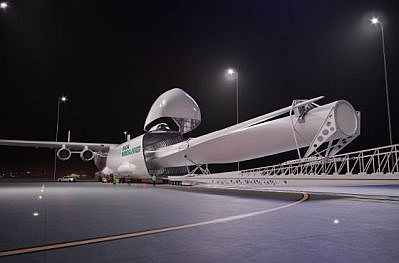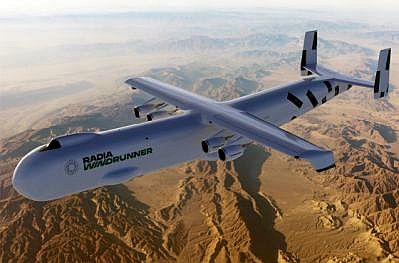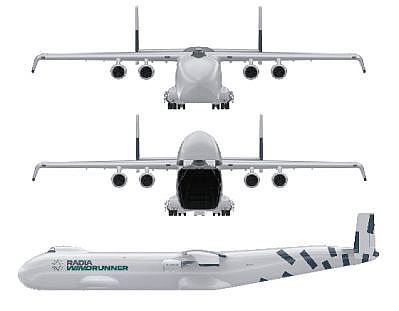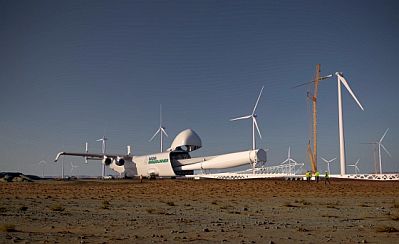Largest Airplane in History
A Colorado startup called Radia aims to build the biggest airplane in history -- longer than a football field with a payload volume 12 times that of a Boeing 747-400F -- to fly large turbine blades and other components directly to wind farm sites on land.

The WindRunner aircraft will have a cargo bay volume of 272,000 cu. ft. [Image courtesy: Radia]
Radia says its unique, front-loading WindRunner aircraft with a wingspan of 261 ft (20 ft longer than a Boeing 747-400F) and an overall length of 356 ft (127 ft longer than the 747) will enable "the deployment of the largest and best-performing wind turbines of the present and future to locations currently inaccessible to wind energy at a scale and speed that was previously impossible."
Total capacity should run about 80 tons. The huge payload bay will be able to fit a turbine blade over 340 ft long. Moving something that long on land would be quite a feat -- and near impossible for many sites, routes with bridges, and mountainous terrain. Today's roads can barely handle transport of turbine blade lengths of 230 ft, according to the company.
VIDEO: Radia Windrunner
Radia's aim is to lead onshore wind energy expansion in partnership with big industry players, and to work with development partners to create new onshore wind farms. The long-term vision is to help provide widespread availability of consistent, low-cost clean energy for the grid, green fuel production, and commercial power users such as data centers.

WindRunner sports a wingspan of 261 ft and an overall length of 356 ft. [Image courtesy: Radia]
So far, Radia has received nearly $100 million in funding from sources including LS Power, Good Growth Capital, Capital Factory, Caruso Ventures, and ConocoPhillips.
According to Radia, the largest wind turbines are the most energy efficient, and doubling the length of a turbine blade roughly quadruples its power output. However, their size restricts them to offshore use.
"Offshore turbines are more than two times as powerful as onshore turbines, because they are bigger," says Mark Lundstrom, Radia CEO. "If we could move these large turbines onshore, they would be twice as profitable and open up three times more land for economically viable wind farms. Why not put them onshore? Because literal roadblocks stand in the way."

WindRunner only requires a 6,000-ft, semi-prepared dirt or gravel landing strip. [Image courtesy: Radia]
Radia's WindRunner aircraft, capable of landing on short, semi-prepared runways including those made of packed dirt, will be purpose-built to deliver these large blades and other components directly to onshore wind farm sites. This should greatly expand the number of locations available for large turbines and enable onshore wind to scale. Opportunities cited by Radia include "reducing transmission costs and increasing reliability by building wind energy sites closer to demand, creating hybrid wind/solar sites to produce clean power around the clock and throughout the year, and generating the large amounts of clean electricity needed to produce green hydrogen."
The company says WindRunner only requires a 6,000-ft landing strip at a wind farm to deliver its payload. Radia plans to produce a fleet of certified aircraft at its U.S. assembly site. To date, the company is more than halfway through the time required to design, build, and certify an aircraft. The company has partnered with leading aerospace firms to design and build the monster WindRunner aircraft.

WindRunner was designed to carry the largest payloads ever moved by air. [Image courtesy: Radia]
Radia and its energy-industry partners have already begun working on multiple world-class green energy "GigaWind" projects that use the giant turbines. These projects include 4 GW in the United States -- enough to power 2 million homes annually. More projects are under development both stateside and internationally.
Want more information? Click below.
Rate this article
View our terms of use and privacy policy ::m::